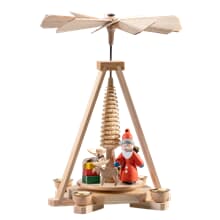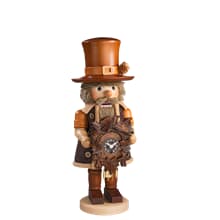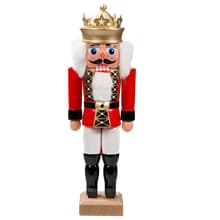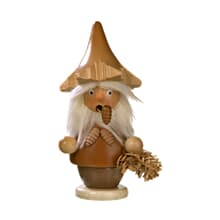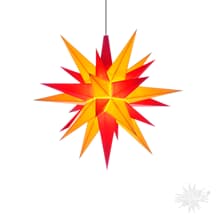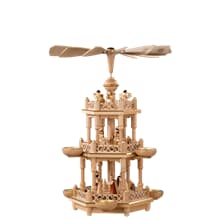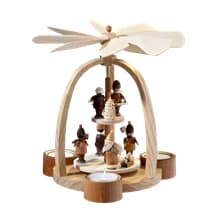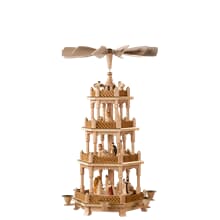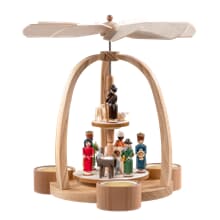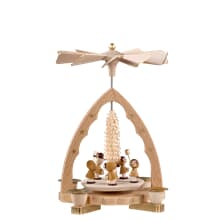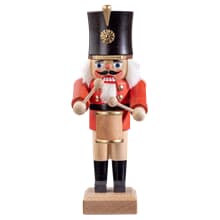Traditional craftsmanship from the Erzgebirge

Traditional craftsmanship from the Erzgebirge
The Erzgebirge in the Czech-German border region is known for its mountainous and forested landscape, for the mining tradition and especially for Erzgebirge folk art. Almost every German associates the name Erzgebirge with wooden art such as the nutcracker or the incense smoker. But also wooden toys, pyramids, angels, music boxes or Schwibbogen testify to the unique craftsmanship from the Erzgebirge, which has been handed down from generation to generation. The diverse wooden figures impress with simplicity, beauty and robustness - a typical Erzgebirge combination.
Tradition in line with new trends
The Erzgebirge folk art does not remain in the past, but combines the change of taste and new trends with the wooden archetypes and traditional craft techniques. There are definitely modern wooden figures and designs that still carry the heritage of traditional Erzgebirge craftsmanship, especially as far as the old craft techniques are concerned. The traditional design language is more and more complemented and extended by modern interpretations. This testifies to liveliness and openness to the new. Only in this way is it possible that the wooden figures and handicraft products have been so successful for centuries and continue to delight new customers in the 21st century. The wooden figures and handicraft products bring every year, not only at Christmas time, many people to shine: Whether it is the nutcracker, a Schwibbogen or an incense smoker. They create a feeling of home and security and often accompany people throughout their lives. The variety of figures, paintings and combinations enchants people again and again.
Traditional woodcraft
Erzgebirge craftsmanship is mostly still real handwork, even if modern machines have meanwhile found their way in. However, industrial production does not take place. Therefore, the handicraft production of Erzgebirge folk art in small family businesses and traditional manufactories differs from industrial imitation products.
The Erzgebirge folk art or wood art is unique and has a long tradition, whose history and spirit cannot be easily imitated. Thus, every purchase of an Erzgebirge handicraft product contributes to the preservation of traditional handicraft techniques and local jobs in the Erzgebirge. The wooden figures and handicraft products are always lovingly handcrafted and an expression of traditional Erzgebirge folk art, which delights visitors and buyers from near and far and not only makes the heart of collectors beat faster. Even if it looks like that at first sight, no handicraft product is like the other; each one is unique. Although smoking men and nutcrackers often appear as soloists, wooden figures and other wooden elements already form wonderful ensembles in the case of pyramids or music boxes, which inspire dreaming.
The history of the people of the Erzgebirge
The Erzgebirge is a low mountain range located in the southeast of Germany and northwest of the Czech Republic. It is also a cultural landscape and historical region. Since the silver-bearing ore was found there in the 12th century, the low mountain range was accordingly called the Ore Mountains (Erzgebirge). Besides iron ore, tin and silver were also mined. These raw material deposits attracted many people who wanted to earn their money in mining. In addition, the raw material boom brought great wealth to the Saxon sovereigns. However, the life of the miners’ underground was hard and meager; they did not have much of the wealth. Nevertheless, they played a decisive role in shaping the face of this region.
Woodworking creates new jobs
In the 17th century, the large ore deposits were exhausted, so new sources of income had to be found in this barren and mining-dominated region. Wood naturally played an important role in mining, as wooden beams supported the tunnels. Moreover, wood from the local forests was still plentiful. After work and in the sparse free time, carving became a popular activity that the whole family indulged in. When mining no longer provided sufficient income, the first miners around Seiffen made woodworking their main occupation. A new main occupation quickly developed, which gave work to many miners.
Seiffen - the roots of the Erzgebirge folk art
Especially popular were the wooden toys, which became an export hit. Around the toy village of Seiffen, therefore, lie the roots of Erzgebirge folk art, which subsequently achieved worldwide fame. Thus, craftsmanship shaped and continues to shape an entire region. Wooden toys and utensils were initially the most important handicraft products and the starting point for further Erzgebirge developments. The typical Erzgebirge figures such as nutcrackers, incense smokers, miners, Schwibbogen (candle arches) or pyramids were quickly created. The Erzgebirge folk art is still an important economic factor and still plays a major role for tourism today.
Unique handicrafts from the Erzgebirge
While wooden toys first established the legendary reputation of Erzgebirge folk art worldwide, traditional wooden figures such as nutcrackers and miners as well as wooden products such as pyramids and music boxes are now in no way inferior to wooden toys. The wealth of types and variants is very large - there is something for every taste. But also, the old handicraft techniques are impressive, because they have survived for centuries and are the basis for typical Erzgebirge handicraft products. Handwork is still the be-all and end-all of Erzgebirge craftsmanship. In addition to woodturning and carving, Spanbaumstechsen and Reifendrehen are typical handicraft techniques from the Erzgebirge, which make special handicraft products possible in the first place.
The wood comes of course from the local forests, mainly spruce or lime wood is used for the creation of Erzgebirge folk art. Each log and each wooden disc is unique due to the grain. Accordingly, no two handicraft products are alike. With each Erzgebirge handicraft product, the buyer acquires a unique specimen, which does not exist a second time. The wooden figures get liveliness due to the natural grain of the wood and the color design.
The woodturning
Woodturning is the basic handicraft technique in the Erzgebirge, because it is through woodturning that the typical figure bodies are made, which are the basis for many wooden figures and handicraft products. During the turning process, a piece of wood is clamped onto an axle, which then rotates together with the piece of wood. During the turning process, the woodturner applies a turning iron to the piece of wood, evenly removing certain areas of the wood to create the desired basic shape for further processing.
Basic shapes include, for example, bodies, spheres, legs, arms, wheels or cylinders. In the next step, such basic shapes are then assembled and glued together before being artistically painted. Most typical wooden figures, such as nutcrackers, mountain men or incense burners, are primarily turned rather than carved. But even with woodturning, a steady hand and a trained eye are important to achieve the required accuracy.
The woodcarving
Carving was and is also extremely popular in the Erzgebirge. In the densely wooded region, it made sense to start carving as a way to compensate for the strenuous work in the tunnels. The carving knife belongs to the Erzgebirge miners just like the miner's lamp. The carving allows very filigree and detailed patterns. In the beginning it was often "only" utilitarian objects or the implementation of special experiences, but the imagination and creativity of the Erzgebirge people knew no bounds even in the past. Thus, it was not uncommon for the entire miner's family to carve elaborate figures and handicraft products in their little free time. The carving knife is used nowadays especially for working the details on the wooden figures and handicraft products.
The “Reifendrehen“
The Reifendrehen is an old Erzgebirge craft, which was invented and also further developed in the Erzgebirge and in which the traditional hoop animals are created. Reifendrehen is a bit rougher than chip tree stamping, but no less challenging for the particular craftsman. In this process, a piece of wood, which is usually spruce, is worked with a turning iron in a wood lathe during rapid rotation in such a way that a wooden ring is created in a first step and contours are turned in a second step.
The contours correspond to the desired wooden figures, for example reindeer, sheep or cows. These wooden figures are created by sawing the wooden ring into small segments at regular intervals. These blanks are then further processed by carving, if necessary, and finally painted. This is particularly how the typical hoop animals are created, which are used as toys or used as figures for pyramids. With Reifendrehen, it is possible to produce many wooden figures in a short time. This was faster and therefore more efficient than manual carving.
The “Spanbaumstechsen“
Another craft specialty of the Erzgebirge is the tradition of Spanbaumstechsen. The basic form is a stick made of a soft wood. Mostly it is lime wood, because lime wood can be worked well in all directions and is not brittle. Uniform chips are removed from this wooden stick with a chisel from the bottom to the top, so that the chips roll upwards in the form of a curl. However, the chips are not completely separated from the wooden stick, but remain connected to the wooden stick. This process is then repeated both side by side around the wooden stick and one below the other: curl by curl. In this way, filigree chip trees are created, which then decorate especially the Christmas pyramid and the candle arch. It is obvious that the craftsman needs an absolutely steady hand and nerves of steel when cutting chip trees, because with a wrong cut a chip leaf is cut off, so that the desired symmetry is lost and the work was ultimately in vain.
Christmas pyramids tell fanciful stories
The single and multi-storey Christmas pyramids are a prime example of Erzgebirge folk art and the creative talent of the craftsmen. Driven by the rising of the candle heat, the impeller and the pyramid is set in motion. Depending on the number and type of candles and the inclination of the impellers, the pyramid rotates sometimes faster and sometimes slower.
As in a movie, the most diverse scenes then pass by the astonished eyes - regardless of whether they are children or adults. Religious scenes, secular scenes or simply landscapes and (historical) life are traced with hoop animals, chip trees as well as turned and carved figures.
With each turn there is a new detail to discover and a story is told turn by turn. Soon the observer loses himself in the realm of fantasy. The crackling and the light of the candles create a cozy atmosphere and anticipation, especially at Christmas.
Uniformed nutcrackers and cute incense smokers
The time-honored nutcrackers usually look quite sinister with their bushy eyebrows. Despite their bared teeth, however, they don't inspire so much awe that you really have to be afraid of them. Rather, in their colorful garb, they perform their powerful task nut by nut. In the face of a nut, they simply have to snap shut with their big mouths.
Imitating soldiers, officers and princes, nutcrackers are usually dressed in uniform and armed. They exude an unassailable authority. The authorities and the servants of the authorities were often a thorn in the side of the common people, because their rules and behavior did not always correspond to the wishes of the people and were sometimes perceived as arbitrariness. But since the Erzgebirge people are humorous, they have immortalized the authorities in wood, to let them crack many a hard nut as punishment.
Meanwhile, there are also nutcrackers that do not belong to the authorities or soldiers. They adapt well to the tastes of their owners and routinely perform their important work at Christmas: Every nut must be cracked. As a rule, the individual parts of nutcrackers are turned and then assembled and glued together. The individual painting gives the particular nutcracker its individual appearance.
In contrast to the nutcrackers, the incense smokers are smaller and rounder. They characterize the "simple man" who smokes a pipe incessantly. The bulging belly and the thick cheeks enable the production of the thickest possible clouds of smoke, which then penetrate through the round mouth to the outside. The smoke clouds are provided by the typical smoking candles. But which came first: The incense candles or the incense smokers? The smoking candles have the longer tradition. Clever craftsmen from the Erzgebirge then designed a cover in the form of the popular incense smokers to provide a worthy setting for the Christmas-scented incense.
The variety of figures of the incense smokers is now enormous. There are not only the tree gnome or the night watchman as incense smokers, but also snowman, Santa Claus, forester or animals spread the spicy-Christmas smells of the scented candles in the premises. Meanwhile, in the spirit of equality, there are even smoking women or entire smoking families.
Schwibbogen, music boxes and Advent stars from the Erzgebirge
Schwibbogen tell of the miners' longing for the light. The miners' lives were typically lived in the dark. Because no daylight penetrated into the tunnels. In the dark season, it was also dark before and after work. The pale pit lamp could not provide any relief. But fire and light were enormously important as an expression of the power of life. So the tradition developed that for the last shift before Christmas Eve, the miners hung their pit lamps in a semicircle in front of the entrance to the mine. The entrance to the mine thus shone with the brightest of lights.
And a light in the window of the home gave the miners security as well as warmth and showed them the way home. The light meant home. At Christmas time, the Erzgebirge people placed a luminous candle arch in their window, which shone even more brilliantly than individual lights. Thereby the Schwibbogen with their chip trees, carved figures and sawed ensembles often reenact Christmas and also regional stories. In principle, a Schwibbogen has the basic shape of a semicircle, but there are also tall Schwibbögen or Schwibbogen in combination with a pyramid in the form of a hemisphere. The creativity of the Erzgebirge craftsmen is limitless. Depending on the design, the light shines either with candles or with electric lighting.
Music boxes are a combination of wood craft and mechanical craft. To a Christmas melody, the wooden music boxes rotate, allowing a Christmas scene to pass by the eye of the beholder. The detailed figures and decorations amaze the viewer. And with every turn there is something new to discover. The melodies stimulate another sense, so that the viewer can enjoy this craftsmanship even with his eyes closed. Christmas music boxes are thus a feast for the eyes and ears.
A music box pyramid represents the combination of a music box with a Christmas pyramid. It is usually larger than a normal music box and, like a normal Christmas pyramid, also has impellers that are powered by the candle heat. Such a music box pyramid then plays Christmas music when the it is set in motion due to the candle heat. Just like pyramids and music boxes as individual specimens, a music box pyramid mainly recreates Christmas or winter scenes. The wooden figures for a music box pyramid are usually carved. In addition, chip trees are often used, which are created by chip tree engraving.
Hanging Advent stars at Christmas time is another popular tradition, in which light again plays an important role. This is because the Advent Star symbolizes the Star of Bethlehem, which led the Magi or the Wise Men from the East to the house where Jesus was born. The Advent Star is thus a Christian symbol, as are, for example, the Christmas angels or the nativity scene. Advent stars are hung either inside or outside buildings. In addition, they also decorate many a fir tree top.

